Finding 12-Volt Short Circuits: Part 1 of 3
Some of the tricks I’ve learned over 50 years of troubleshooting electrical systems….
Dear Readers,
I’ve received multiple requests for articles and videos on how to diagnose and repair “shorts” – which I’ve been putting off. The reason for my delay is that short circuit diagnostics is not a simple thing. To do it with any amount of safety and certainty you first need to understand what short circuits are, how they occur, and their various flavors. That’s why I’m presenting this as a 3-part series.
It’s a little bit complicated
In Part 1 I’ll explain the basics of complete circuit paths; Part 2 will cover diagnostics of shorts in 12-volt DC systems; and Part 3 will show you how to find various types of short circuits in 120-volt AC systems. Yes, I said various types of short circuits since there are a lot of different ways that circuits fail.
If I can get around to it I’ll then create a Part 4 video demonstrating a few of my diagnostic tricks for finding shorts in extended wiring systems. You see, I’ve been doing this for 50 years and have created a number of unique test methods that speed up troubleshooting short circuits.
Safety First!
While the basics of troubleshooting short circuits is simple, there are a few dangers involved if you don’t do this correctly, so I’m marking this article as Advanced. DO NOT attempt to diagnose live circuits yourself unless you have the proper training and take safety precautions.
Remember: Once we start working on 120-volt circuits there will be potentially lethal voltages involved, and even 12-volt circuits can create all sorts of wiring meltdowns and fires from huge currents. So, safety first!
Everything you know is wrong!
Okay, it’s time to define what a “short” circuit is and is not. I would say that at least 90% of the time when someone blames a problem on a “short” it’s not a short circuit at all. In fact, the majority of times it’s usually the opposite of a short circuit – it’s an open circuit or a high-resistance connection. What a “short circuit” really means is a “shorter circuit” than the “complete circuit” intended by the design. So, to understand “short” circuits, we first have to understand “complete” circuits. So strap in, and let’s get started.
Open circuits
Now here’s where you get to learn how to read a simple schematic, the basis for all troubleshooting. As you can see in the diagram there’s a 12-volt battery, a fuse, a switch and a light bulb. You can tell by the position of the switch that it’s open with an air gap, and no electrons can jump across it. So we say this switch is “open” and there’s not a complete circuit path for the electrons to move around as a current. And, of course, without any current flow there’s no energy flow in the light bulb, so the the bulb is out. Does this make sense so far?
Complete circuits
In the next diagram I’ll close the switch (complete the circuit). Now there’s a complete circuit (pathway) for the electrons to move around in a circle. The current passes through the fuse, through the switch, through the filament of the light bulb (where it produces heat and light), then finally back to the battery.
This is said to be a “complete” circuit since now the battery is supplying about 1 ampere of current to the light bulb, which is turning it into 12 watts of heat and light. Of course the exact amount of current (and wattage) depends on the exact wattage rating of the bulb, so this is just one example. Because we’ve installed a 5-amp fuse, and only 1 ampere of current is passing through it, all is well and the bulb will remain lit for many hours until the battery runs down. This is essentially the same circuit you might have in your RV refrigerator that turns on the light inside when you open the door, and turns it off when the door is closed. Still with me?
Short(er) circuits
Finally, there’s what happens in a “short” circuit; that is, instead of making the complete circuit path through the light bulb, something has happened in the wiring to make a “shorter” circuit than intended. So instead of the current pushing through the light bulb filament, there’s a “short” in the wiring between the red positive wire of the battery directly back to the black negative terminal of the battery.
What’s Happening???
Now instead of the light bulb limiting the current though the wires to around 1 amperes, it’s going to try to push 100 amps (or more) of current through the circuit that’s a “short” path. That’s why we call it a “short” circuit. Something conductive has jumped between the wires to create a shorter path for the current to return to the source. The 5-amp fuse will quickly blow in this case, protecting the wiring. But you can imagine that if the fuse wasn’t there to interrupt this huge current flow, the wiring would quickly overheat and burn up – in many cases starting a fire.
Fuse safety
That’s why it’s really important to NEVER bypass a fuse or replace it with one that has a higher current rating (or a bullet – see photo!). The fuse (or circuit breaker) is there to protect the wiring from harm in the event of an over-current caused by a short circuit, and can only do its job if it has the proper current rating.
I should also note that there are at least two types of short circuits, the first one being a direct short between the positive and negative wires of a battery circuit (or line and neutral in a 120-volt circuit), which can occur when someone drives a screw or nail through a cable.
Fault paths
The other type of short circuit is a fault path created between a wire and something metallic, like an extension cord run through a window or door where the insulation has worn off on the hot conductor and makes direct contact with the metal of your RV (or an appliance). In that case the current path will be a little different, but certainly shorter than intended.
This can create a hot-skin/contact-voltage situation that includes your body in the fault current path, which is something you definitely don’t want to have happen. As you all should know by now, contact with 120-volts AC can be very dangerous for you and your pets.
There’s also intermittent as well as hard short circuits, with the intermittent ones that blow a fuse on occasion being the most frustrating (read expensive) ones to find and fix. Yes, the once-a-week blown fuse takes some special techniques to find.
Stay Tuned for More…
So tune in next week for Part 2 on how to begin diagnosing a short circuit in the 12-volt DC system of your RV. I have a few really cool diagnostic tricks I’ve developed over 50 years of doing this that you’re gonna love. See you then.
In the meantime, let’s play safe out there…. Mike



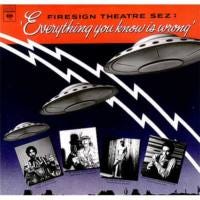
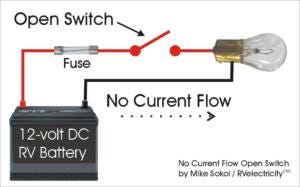
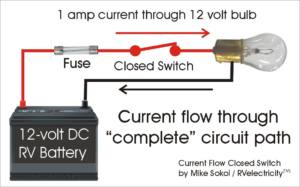

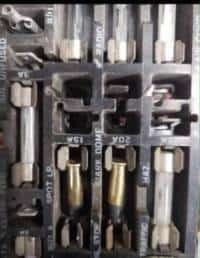
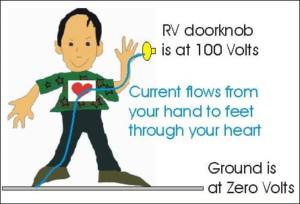

Why is the current flow arrow In the closed circuit picture pointing to the left and in the open circuit picture the no current flow arrow is pointing to the right?
Many moons ago,, in the military, the most damning thing a senior electronics instructor could say about a young service member appearing before an academic review board, after months of specialized training, was:
“He (or she) doesn’t know the difference between a short and an open.”
Ouch!